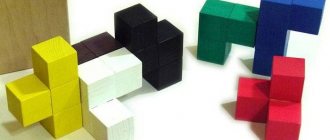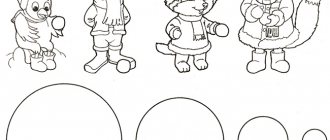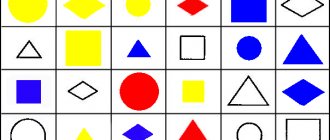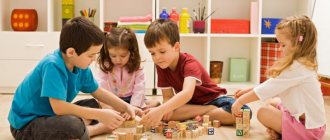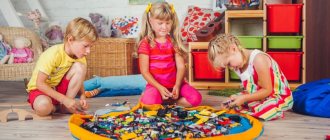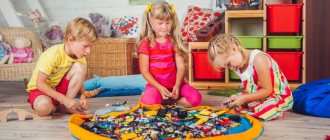Parents who seriously think about the future of their child try to start their education from an early age, using the experience of past teachers who have proven the validity of their views in practice. Nikitin’s methodology, which is aimed at the development and education of children in a playful way, does not lose its relevance.
Physical development of a child according to Nikitin
Childbirth: what needs to be done
All doctors, psychologists, teachers express a common opinion - the health of the child largely depends on how the birth went. Lena and Boris Nikitin, parents of seven children, wrote a book: “A request to the doctors and nurses of the maternity hospital,” the contents of which are still relevant for many maternity hospitals.
Let's consider the key points of the Nikitins' book:
- Lack of anesthesia during childbirth. The fact is that anesthesia is harmful for a woman in labor, and even more harmful for a newborn child. Anesthesia cannot drown out the pain of labor. Childbirth, if possible, if there is no pathology, should take place naturally.
- The umbilical cord should not be clamped or cut immediately after birth. As long as the umbilical cord transmits blood to the baby, he should receive it. In order to restore strength after childbirth and not develop hypoxia.
- As soon as the baby is born, put him to the breast . The umbilical cord has not yet been cut. Sucking and closeness to the mother will calm the baby and give him a feeling of protection. For the mother, this is also beneficial and natural, since feeding the baby provokes contraction of the uterus, the release of blood accumulated in it after childbirth. And, most importantly, it stimulates the formation of breast milk.
- After childbirth, a newborn child should not be separated from its mother . Mother and baby should have a warm relationship, affection, unconditional love, which is necessary for every person throughout life. And this family attachment begins from the first days spent with mother.
- Feeding at the baby's first request. You should not impose your feeding regime on your child. If he wants to eat, let him suckle, even at night. All living things on earth have no feeding regimes. A calm and well-fed child is healthy development.
- Do not keep your baby in diapers all the time . Tight swaddling prevents the baby from moving freely. The world around him should awaken interest and curiosity in him, which will form educational motivation in the future.
- Strengthen the child from birth. Air and sun baths, water procedures should begin from the moment of birth.
How should you raise a child?
The Nikitins emphasized the importance of maintaining physical contact between mother and child for as long as possible. For the full development of a child, the closeness of the mother is as important as various developmental exercises. They recommended putting the baby to the breast immediately after birth, and not taking it away (as was done in the USSR and is sometimes practiced now).
The Nikitins condemned the strict daily routine for a preschooler. After all, a clear routine and compulsory classes can both tire a child and make him dislike classes. They believed that it was necessary to create an environment that would stimulate his desire to learn and explore. Playpens and strollers are a prison for a child, the Nikitins believed.
There are often two extremes of parenting:
- Overorganization or overprotective care, continuous activities and games and lack of time for independent development.
- Abandonment or parents doing the bare minimum (feeding and putting them to sleep), which can lead to mental retardation.
However, there is a third way in raising a child. The child is the master of his actions and routines. A parent is an assistant who will help you understand a complex problem, without forcing or obliging you to do anything.
Hardening children according to the Nikitins' method
Basic principles of hardening according to the Nikitin method:
- The first physical training begins in utero. During a normal pregnancy, the mother should actively move and engage in physical exercises.
- Children should not be overwrapped or overheated . Try to wear only light clothing while awake. Especially in the warm season: a T-shirt and shorts are enough.
- The room temperature should be no more than 18 degrees . This allows you to keep the child’s body in good shape, which is also a kind of exercise.
- Early air baths. Newborn children in the Nikitin family took air baths every day. And when the child was two months old, the child was taken out into the cold for a few seconds every day. I must say that the children really liked these procedures and in the future they never got sick!
- Dipping a child in cold water from the first days of life . Nikitins advise immersing a newborn baby in cold water with his head. This triggers a very important mechanism of thermoregulation of the body.
- Walk barefoot more. Cold feet of a child are normal! The child should walk barefoot all day and only before going to bed should the feet be washed and warmed up so that the child can relax and fall asleep.
- Physical exercise . The Nikitins recommend that parents do simple physical exercises with their newborn children. Especially those that reinforce unconditioned reflexes. For older children, the Nikitins developed a system of sports corners and equipment.
- Food restriction . The Nikitins are convinced that excessive overeating of a child is more harmful than mild hunger. Don't overfeed your children and they will always have an excellent appetite.
- Lack of daily routine . The Nikitins believe that the regime overtires the baby. The more “obligations”, the less interest. Children should exercise as much as they want, often changing between active (physical) and sedentary (intellectual) activities.
- Freedom to move . As soon as the child begins to crawl, give him complete freedom of movement. But for this you will have to prepare the apartment (secure it). Strollers, walkers, jumpers and playpens are prohibited! Allow your child to play with more than just toys. Introduce your baby to kitchen items, tools, and appliances.
- Combating a sterile environment. There is no need to isolate children from the world. They need information! Let them crawl, touch and even put in their mouth. This knowledge is irreplaceable. Your task is to clean, within reason, if you have a small child at home.
What is the essence of the technique
What is this – an education system or a way of life? So, let’s figure out what the essence of early development of children is hidden according to the principles of the Nikitin family.
It all starts with the consciousness of parents and their active participation in the lives of their offspring. It is the responsibility of the spouses to understand and accept such fundamentals.
- Away with all medications. Renewing communication with nature and understanding the natural processes of life. Minimal medical intervention during pregnancy and childbirth and putting the baby to the breast from the first minutes of life.
- Down with the sedentary lifestyle. Active pastime in the fresh air is instilled from birth. Hardening, gymnastics, swimming and sports (outdoor games) are the best medicines and doctors. The uniform is light, and barefoot, even in the snow.
- Make way for the timely intellectual development of the child. It is necessary to think about education from the very conception. A healthy lifestyle for mom and dad, healthy food, good music and as much communication as possible. From birth, a home environment rich in variety will help your baby learn everything easily.
- Do all the housework together, go on hikes together, play sports, and play games. Friendliness, mutual assistance, mutual respect, love, support in everything. Sincere interest of parents in all the affairs of the children.
- You give children complete freedom in choosing games and activities. Independence and a rich creative environment for all kinds of activities from the first days of life.
Talents reside in abundance in every little one. The teacher is confident that the child should be given maximum knowledge in preschool age.
Since from birth to 7-10 years of age, a child’s enormous opportunities to express themselves in almost any field of activity are launched. Moreover, all abilities are very strongly interconnected. Consequently, the sooner a little one begins to crawl and run, the sooner his consciousness develops and his talents appear. With age, they are irretrievably lost.
Nikitin's intellectual games
“Tell me and I will forget.
Show me and I will remember.Let me do it myself and I’ll understand.”
Nikitin developed educational games for children of any age. They develop a child’s attention, logic, memory, imagination, creativity, patience and perseverance. For a child to understand how to play, a parent needs a personal example, and then the child plays on his own, without anyone else’s participation.
Features of Nikitin's intellectual games:
- Nikitin's educational games include various puzzles, cubes, construction sets, tables and logical tasks.
- The tasks have different levels of difficulty, both for young children and for high school students.
- You need to play mind games from simple to complex.
- The tasks the child performs are presented in the form of visual teaching material. The correctness of the solution can be verified visually.
- You cannot demand that a child solve this or that problem. The desire of the child himself is primary.
- Almost all of Nikitin’s games assume that you can come up with your own problems and solutions to them.
- An adult should not tell a child. He must think for himself.
- Parents should praise their child for successfully completed tasks, motivating them to continue playing with games.
- If your child gets tired, end the lesson immediately. It’s better to stop on a good note so that the desire to play arises again.
Boris Nikitin described his educational games in the book “Intellectual Games”. Many of Nikitin's intellectual games aids can be made with your own hands. Or you can buy ready-made Nikitin games and manuals.
Description of developmental tasks
All educational games B.P. Nikitin can be purchased on the family selling website, as well as in stores. You can start getting acquainted with educational games with Nikitin's cut square. The game is called "Fold the Square".
Collecting Nikitin's square will be interesting for the whole family, as the game evokes real sports excitement.
It seems that no one will be able to put together a figure, but the despair that arises in the process of a family competition gives hope of victory and forces one to achieve the goal. The game is more intended for preschoolers and is designed to develop:
- ability to think logically;
- the ability to analyze the conditions of a problem and logically come to the right solution;
- skill of a creative approach to implementation;
- idea of geometric space;
- color perception.
The set contains 36 squares of different colors. One is a sample, the rest are cut in various ways from simple to complex. Goal: make squares from individual parts.
One of the kids’ favorite games is “Fold the Pattern”. Children are interested in how individual cubes create a wonderful pattern. You can play from the age of two. Babies develop:
- visual thinking;
- color perception;
- ability to compare and combine;
- visual memory;
- self-control;
- attention and perseverance;
- imagination.
The game set includes 16 wooden cubes of the same size with edges painted in different colors, as well as tasks. The child plays with blocks and at the same time makes a beautiful pattern. The little ones can use the app for the game - an album where the pictures are enlarged, and each task is located on its own page.
The game “Unicube” can be played by children from 3-4 years old, but it also gives a lot of joy to older children, and dads are simply crazy about it. It will appeal to everyone who wants to test their ingenuity and intelligence. The box contains 27 cubes, which are painted in only three colors: yellow, blue and red. The instructions contain 60 puzzle tasks.
The work begins with collecting the model, focusing only on external similarity in color.
Then the task becomes more complicated: now the baby must see the internal contents of the model. The most difficult task is to place the cube, taking into account all six sides.
Game "Fold the pattern"
The set contains 16 cubes with multi-colored edges. The game develops basic math skills. You can start playing it as early as 1.5 years old.
- Look at the cubes with your child, learn the colors, count their number. This game is for the little ones.
- Show your child that you can build paths from blocks. Wait until the child wants to make the path himself. First, a path of one color (yellow for the “bunny”, and red for the “bunny”). At the same time, we pronounce and fix the name of the color.
- When the child learns to build one-color paths, show how to build multi-colored ones. Here you can study the pattern and sequence: “Look at my path. What did you notice? - Yes, the cubes are blue, yellow, blue, yellow, and which one is next? Continue the path. If you want, come up with your own colorful path for your little fox.”
- After these games, it's time to make patterns from the cubes. First, like my mother’s, then like Nikitin’s manual. Later you can come up with patterns yourself.
Game "Fold the square"
This game consists of colorful squares cut into pieces of different shapes.
This game has three difficulty levels.
| Difficulty levels | I | II | III |
| Number of square components | 2-3 | 3-5 | 4-7 |
| Recommended age (years) | 3-4 | 4-5 | 6-7 |
When playing with your child, do not forget to name the shapes that make up the squares: triangle, trapezoid, etc. You can count how many angles and sides there are. Also called the color of the figure. Pay attention to the child that, for example, triangles come in different sizes and shapes. Here you can also introduce the concepts of “whole” and “part”.
The game develops imagination, logical thinking, fine motor skills, as well as imagination and combinatorial abilities of children.
Types of Nikitin cubes
Practical teacher Boris Nikitin developed his own method of educational games 40 years ago. The first children to grow up with his toys were the teacher’s own grandchildren. Now educational games are known not only in Russia, but throughout the world.
Before you decide to buy, decide what qualities you would like to develop in your child: logic, eye, imagination, logical and spatial thinking, etc. Based on this, choose a set. Nikitin’s method for children leaves room for choice to suit every taste: decide what colors the edges will be painted in, how many parts the manual consists of.
Fold the pattern
The simplest option is a set of 16 plastic or wooden cubes and an album with tasks, packed in a box. This technique is also called Nikitin's puzzles. It is suitable for beginners.
- Model name: “Fold the pattern” set
- Price: 550 rubles
- Characteristics: educational methodology for preschool children, the product is available in different colors.
- Pros: develops imagination, color perception, ability to combine, mental operations of comparison, analysis and synthesis.
- Cons: the cubes are very small (2:2 cm).
Fold a square
For children who have already mastered the simplest tasks, game options with unevenly colored figures are suitable:
- Model name: “Fold a square set”
- Price: 3500 rubles
- Characteristics: a set of three parts, each containing 12 squares of different colors, which are divided into parts (triangle, rectangle, etc.). This game is intended for children from two years old. The child will have to put the cut square back together.
- Pros: develops logical thinking, ability to complete the whole, eye...
- Cons: presence of small parts, chips and burrs on the squares, and high price.
- How to fix bad credit history
- Cherry jam Pyatiminutka
- Good liquid for removing shellac from nails
Unicube
A useful skill will be the ability to assemble three-dimensional shapes - from geometric ones to funny houses or animals. There are special kits for this:
- Model name: “Unicube set”
- Price: 680 rubles
- Characteristics: The puzzle consists of twenty-seven universal six-sided identical cubes with colored edges. It is necessary to assemble three-dimensional figures from them. The game can be offered to children from one and a half years old.
- Pros: develops spatial thinking, the ability to combine, self-control.
- Cons: none found.
Cubes for everyone
When the child gets comfortable with the blocks, you can offer him one of the most difficult games in the series. At an advanced level, children can assemble objects from two or three figures - animals, a house, cars. The expected age of the child is 5-7 years.
- Model name: “Bright Cubes Set”
- Price: 590 rubles
- Characteristics: the puzzle consists of seven complex figures that differ in shape and color. The kit includes a brochure with sample assignments.
- Pros: ability to combine, attention, imagination.
- Cons: presence of chips on the edge of the cubes.
Bricks
Those parents for whom the environmental characteristics and safety of toys are of great importance will like the variation with wooden blocks. They are more durable, although your baby may prefer less of the bright, lightweight plastic cubes.
- Model name: “Bricks for little ones” set
- Price: 400 rubles
- Characteristics: Includes eight wooden blocks with single-color edges and a notebook with tasks. The child's age is from three years.
- Pros: helps develop visual-effective and spatial thinking, eye.
- Cons: not found.
Game "Fractions"
The game consists of three plywood boards with 4 circles each. They are all the same in size, but different in color. The first circle is solid, the second is divided into two identical parts, the third into three parts, and so on, up to 12 parts.
First, the first plywood with four circles is introduced into the game. The first thing you can do is say the colors, count the pieces, and compare their sizes.
What to do next with this?
- Invite the child to put pieces of the same color into separate piles.
- Ask the child to make circles of the same color from the resulting piles.
- Explain to the child how the names of one part of the circles are obtained (1/2, 1/3, ¼, 1/5, etc.)
- Play the game: put one piece of different color in a row in ascending order.
- Invite your child to experimentally find out which part is greater than 1/3 or ½. How can this be checked?
- Ask: How many quarters fit on one half? What about sixth parts? Eighth?
- What parts will fit into 1/3?
- How to make a whole circle (two-color, three-color, etc.) from parts of different colors?
- How many whole multi-colored circles can you add together? Etc.
Achievements and advantages of the Nikitin system
The Nikitins' research and experience are a source of ideas for a new integrated pedagogy: a synthesis of physical and intellectual development, education, and social adaptation.
The Nikitins’ activities laid the foundations for “conscious parenthood.” The secret of her success is her playful approach to learning. The Nikitins' merit is that they were able to create a developmental environment (educational things + educational games + educational tools) out of ordinary everyday life.
The system has been tested by time and has shown many positive aspects:
- reduction of school time by 1/3;
- using the freed up time to gain social and labor skills and creative activities;
- effectiveness - confirmed by the health of children;
- development of efficiency, independence, ability to take a hit, solve complex problems at the trial and error level;
- early development of mind and body;
- intellectual educational games;
- The concept of establishing abilities at an early age (NUVERS) has been developed.
Game "Cubes for everyone"
The game develops spatial thinking abilities, helps to master graphic literacy, and understand drawings before school.
You begin your classes by showing your child a drawing task and asking them to build a model of the drawing using cubes. Having successfully constructed one, move on to the next more complex drawing.
The child needs to choose the right ones from all the figures and place them correctly in the model.
Creative work begins when the child comes up with his own models and uses them to draw a drawing task for adults.
Algorithm for involving a child in the game
- Completely voluntary.
- Games are not explained to the child, but are attracted to them through a fairy tale and imitation of elders.
- The game is learned together with adults, then the child practices on his own.
- The adult constantly sets ever more complex tasks for the child. Hints are excluded.
- If you fail, there is a temporary rollback to an easier task or the game is paused.
- When reaching maximum achievements in the game, it is postponed.
- If you lose interest in the game, it is temporarily postponed. The child must return to her on his own.
- Winning a game raises the child one step in development and stimulates further knowledge.
The Nikitins have developed several types of games: intellectual, creative and game-playing.
Intellectual games are aimed at developing mathematical thinking, spatial imagination, and logic. Ability to synthesize and analyze, prepare for drawing, stereometry and descriptive geometry. These games require additional items and aids.
Game "Unicube"
These universal blocks are for children from 2 to 15 years old. They develop spatial thinking, teach clarity, attentiveness, precision, accuracy.
All 27 cubes are different, although only three colors are used to color them. First, parents ask the child to find a cube with two sides of the same color. Then build a “tower”, “house”, “ladder”.
The tasks in Unicube are difficult; you cannot give too many of them at once. Most often, one task is enough, less often two or three, depending on the child’s abilities.
Children are given tasks either through drawings or orally. It is necessary to gradually lead the child to understand tasks well both orally and in the form of drawings.
All mental and construction work should be carried out by the child independently, without adult intervention. The adult’s task is to rejoice at the successful completion of the task and praise the child for his efforts. If you fail, you are upset, but you believe that tomorrow or in a week the child will definitely succeed.
The fate of the Nikitin system
In 1970-1980 The Nikitins’ methodology aroused great interest: books sold in millions of copies, over 1000 guests visited their house per year, meetings and lectures were overcrowded with people interested. They supported the pedagogical ideas of the Nikitins:
- Academician N.A. Amosov - cardiac surgeon, gerontologist;
- Professor I.A. Arshavsky - physiologist;
But official pedagogy did not recognize the achievements of the Nikitins, neither in the process of creating the system, nor today. On the contrary, the state created all sorts of obstacles to the family and the dissemination and popularization of their pedagogy:
- slander was launched in the press and on TV;
- kindergartens and schools were prohibited from using Nikitin’s methods;
- Boris Pavlovich repeatedly quit his job for no reason.
Until now, neither the APN, nor the Ministry of Education, nor the Ministry of Health have been interested in the Nikitin NUVERS hypothesis. Official pedagogy forgot about the innovative family system. On the contrary, in Germany, teacher’s books are systematically published, the “Institute of B.P. Nikitin”, in Japan the methods are widely used in kindergartens.
Nikitin assumed that others would learn from his living experience, who would go further and continue his work. But there are no true successors and developers of Nikitin’s work (except for his children, who use the system in their families and promote the system of their parents). In Russia, the question of the survival of the Nikitins’ educational system remains open.
How to play Nikitin's games
And in conclusion - a few general rules for all Nikitin’s intellectual games.
- Games should not be freely available to the child; take them out only when the baby is in the mood and wants to play them.
- Don’t be upset if your child fails to complete the task the first time - perhaps he is not yet mature enough and will succeed later.
- The child should retain the feeling of being “underplayed” and not “overplayed,” so finish the game before he gets tired.
- Get creative with your games. Together with your children, come up with new types of patterns, drawings, and game options.
- An adult should not perform a task for a child, point out mistakes or give hints. You can only push the child and help him find the right solution on his own.
Biography of the Nikitins:
- Boris Pavlovich (1916 – 1999).
- Lena Alekseevna (1930 – 2014).
In 1916, in the village of Suvorovskaya (Stavropol Territory), Boris Nikitin was born into the family of a military paramedic and a hereditary Kuban Cossack.
In childhood and adolescence, he himself developed extraordinary technical abilities and was also fond of sports. In 1934 he graduated from school with honors and studied at an industrial institute for three years.
In 1937 he entered the Zhukovsky Air Force Academy.
In 1939 he got married. In 1941, he had a daughter, and in 1943 and 1946, sons.
In 1941, he was admitted to early graduation and received the specialty “mechanical engineer for weapons.”
From 1941 to 1946 he served near Saratov in a reserve air regiment as an instructor, and then continued his service in Noginsk near Moscow.
In 1949, he was demobilized and moved with his family to Moscow to live with his mother-in-law, began scientific and teaching activities at the Research Institute for Labor Reserves, and for the first time openly expressed his disagreement with the official methods of educating young people. He was fired and moved to the Research Institute of Theory and History of Pedagogy.
Divorced in 1954. Nikitin changes many jobs, trying himself in the teaching field. Since 1949, he seriously began studying Makarenko’s pedagogy and conceived the idea of creating a commune school for normal children. Over the years he has been nurturing this idea, looking for like-minded people, trying to achieve official permission. His idea was not supported, the school was not allowed, and repression rained down on the innovator.
In 1958, he met at a teacher's meeting with Lena Litvinova. They begin a long life together.
Lena Litvinova was born in 1930 in a village near Moscow. Bolshevo (now Korolev) in the family of a teacher and a military engineer. She graduated with honors from school (1948) and the Moscow Library College (1950), and in 1954 she graduated from the philological department of the Moscow Pedagogical Institute.
After college, she worked as a literature teacher in Altai (Voyevodskoe village) for 2 years. Here I began to develop my language teaching methods.
In 1956 she returned to Moscow and taught at railway school No. 40.
After marriage from 1960 to 1980 worked as a library manager in Bolshevo. From 1960 to 1998, Lena continued her research and teaching practice in kindergartens, schools and her family.
In 1959 she gave birth to her first child. Then every two years a child appeared in the family. By 1971, the Nikitins were already raising 7 children, while at the same time developing their system live and applying it to their family. From the same year, Nikitin entered the Research Institute of Psychology. Here he began developing the topic “Development of technical creative abilities.”
He accumulates material about the rapid early development of a child, explores the idea of irreversible decline of abilities, and puts forward recommendations for “Childhood without illnesses.” There is already enough material to start making it public. In 1962, the first publication appeared in the press about a strange large family with its own educational system. The experience was positive. 1965 - The first film "Are We Right?" was released. about the experience and opportunities of ERD (early developmental development) in the Nikitin family.
In 1965, Nikitin was fired from the institute due to non-standard approaches to education. He begins teaching at school, while simultaneously turning his family into a research laboratory for innovative parenting. In the 70s newspapers began to publish articles about Nikitin en masse. In the 80s Boris Pavlovich was in a group of innovative teachers and published in the Teacher's Newspaper; he was one of the developers of cooperation pedagogy. His family became very famous.
Although the state did not support his family, popular popularity was enormous: teachers and parents came to Bolshevo on their own. In the 90s The Nikitins actively popularize their pedagogy. In 1992, the Nikitin Author’s Pedagogical Center (APTC) was opened on the basis of the school in Korolev. It was a creative laboratory for young teachers. The Nikitins, due to their age, wrote only the concept of continuous education for her. By 1997, the center's work had faded.
In 1999, Boris Pavlovich died in Moscow after a brief illness, and in 2014, Lena Nikitina died in Korolev.
Pros and cons of the Nikitin methods
The “advantages” of the Nikitins’ technique are:
- The child develops well physically, gets sick little, and is hardened.
- A child early learns to think logically: to generalize, highlight the main properties, draw conclusions and apply them in practice. Able to apply acquired knowledge in further games.
- Development of visual, auditory, motor memory;
- Development of interest, curiosity and learning motivation;
- Development of independence;
- Development of creativity, creative imagination
- The technique well prepares the basis for the study of exact sciences.
«Disadvantages of the Nikitins’ technique:
- The Nikitins' method needs to be supplemented with other developmental programs, since it does not contain games that teach reading or preparation for writing.
- Hardening methods are considered too radical; not all parents will follow this example. It will be necessary to obtain recommendations from a pediatrician.
- Not everyone will like the spartan living conditions and malnutrition.
- The Nikitins in their education system do not provide for children's role-playing games at all. The Nikitins’ child should not play with cars, dolls, shops, “war games” and “mothers and daughters”. From early childhood he must be accustomed to work and self-service. Must be able to manage a household. But he just doesn’t know how to play.
If the Nikitins’ methodology is perceived as a good tool for the development of a child’s logic, mathematical skills, and physical development and is supplemented with other good tools for more comprehensive development, then this will be an excellent option for parents, teachers and psychologists. This is what Elena Danilova describes in her book “A New Look at the Nikitins’ Games.” It complements and enriches the tasks for Nikitin’s games and helps parents look at his games a little differently.
Principles of raising Nikitins
- Freedom of creativity. There is no need for special classes or training; the child does as much as he wants.
- Sports atmosphere in the house + light clothing. Sports equipment should be present at home from early childhood. Children should be hardened from infancy.
- Parents' participation in the child's life. It is necessary to create conditions for the development of the child, taking into account the wishes of the child himself, and not focusing on his own interests. Never do for a child what he can do himself.
- Favorable conditions. Creation of advanced conditions for development. For example, as soon as the child began to speak, the alphabet and abacus appeared in the toys.
- The principle of NUWERS is the irreversible extinction of opportunities for effective development of abilities. It means that there is a certain time and conditions for the development of specific abilities, if they are not developed in time, they will be lost.
